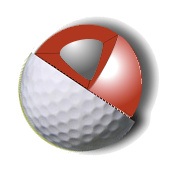
Golf balls are no longer stuffed with tightly coiled rubber bands or covered with marshmallow-soft material. But they still follow the same basic rules of construction as their forebears.
That is, more layers (pieces) equal more spin, while fewer layers equal greater distance.
To be sure, the line between so-called tour performance balls and their long-distance brethren has been blurred. High-spinning models are far more durable these days, and there's less of a yardage gap between tour and distance balls.
Here's a brief tutorial on golf ball construction:
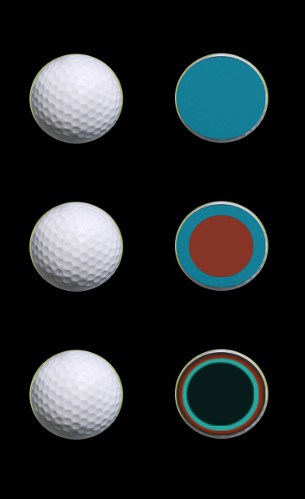
Two-piece/Layers: A thin but tough outer layer envelops a large, solid core. Spin is minimized, delivering maximum distance but also reducing the amount these balls will slice or hook. Examples: Top-Flite D2+, Titleist DT Solo.
Three- and four-piece/Layers: Most tour models feature three or four layers: a relatively soft cover, one or two intermediate pieces, and a solid (sometimes liquid) core. Their high spin rates provide excellent greenside control and allow skilled golfers to play shots like draws and fades. Examples: Titleist ProV1 (three-piece), Bridgestone B330 (four).
Five-piece/Layers: Introduced in 2010, the TaylorMade Penta is the first five-layer golf ball. It features similar benefits to the three- and four-piece models.

Golf Ball Layers Determine Spin, Distance
There is an argument to be made for the idea that the golf ball is actually the most important piece of equipment in your bag. At first, you might laugh at such a notion – after all, you probably spent $300 or more on your driver, and your set of irons may have cost $600, $700, or more. However, despite the money that you have invested in your set of clubs, the golf balls rolling around in the bottom of the bag may have more to do with your final score than any of the 14 clubs you are carrying. The ball you play will have a lot to do with the spin you create, the distance you achieve, and ultimately the score you shoot. If you are able to pick out a ball that matches up nicely with your swing and your ability level overall, you will be able to raise your level of play without making any other changes.
Of course, as soon as you walk into your local golf shop to pick out a new golf ball, you will realize there is a problem – there are countless different models on the shelf for you to pick from. This process would likely be pretty easy if there were only three or four kinds of golf balls on the market, but that is not the case. Rather, there are dozens of different models to consider, coming from a selection of various brands. These different models have a variety of price points, they each claim to offer some type of advantage over the others, and they all have stats on the packaging that are supposed to entice you to pick that specific ball.
To the golfer who does not understand the basics of golf ball design and marketing, it can all be a bit overwhelming. So, before you even head to the store, it is a good idea to educate yourself on what it is that you should be looking for. With a good idea in mind of which balls are going to fit your game, you can make the shopping experience quick and painless. Ideally, you will find a ball that you like, and you will stick with that ball for years to come. Changing golf balls is likely changing clubs in that it will 'mess up' your feel for a period of time – if you can stick with the same make and model for a number of seasons, you will play better in the long run.
In this article, we are going to address the issue of layers within a golf ball. Different golf ball models have varying numbers of layers, and that number will have an effect on the performance of the ball. Generally speaking, all of the models that you find available today will have somewhere between two and five layers. While the number of layers doesn't tell you everything that you need to know about a ball, it does give you a good basic indication of the performance that you can expect. Once you narrow down how many layers you should be looking for to match up with your ability level, you can then get to work on picking out a specific ball.
All of the content below has been written from the perspective of a right handed golfer. If you happen to play left handed, please be sure to reverse the commentary as necessary.
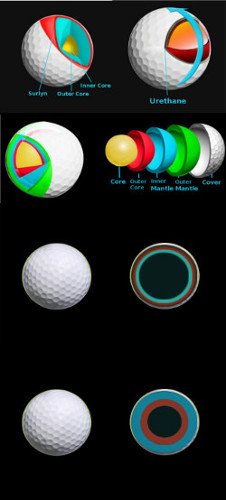
The Basics
Unless you are a serious golfer with a long history in the game, you may not even know how many layers your current golf ball uses in its construction. That's okay – you will only need to learn a few basic points and you will be up and running on this topic. Simply put, more layers usually equal more spin. That isn't a hard and fast rule, of course, as there are other elements in play here as well. However, for the most part, if you want to get a golf ball that spins at a high rate, you are going to want to find more layers.
At the bottom of the market are the two-piece golf balls ('piece' is just another way of saying layers in golf ball speak). Two layer balls are typically the least expensive models you will see on the shelves, and they are going to provide you with the lowest amount of spin in most cases. These are often referred to as 'hard' golf balls by experienced players, as they have a firm feel at impact and they make a slightly 'clicky' sound when coming off of the club face. If you are a beginning golfer, a two-piece ball is going to be a perfect choice. They are affordable, they are durable, and you won't worry too much if you lose a few of them along the way. For the beginner, heading to the golf shop and finding an affordable two-layer ball is the right way to go.
However, if you are looking for more performance in your golf ball, you will want to move up into the realm of three-piece and four-piece golf balls. The golf balls in this category are going to spin more than the two-piece models, and they will likely cost more as well. This segment of the market includes the golf balls that you will see used on the professional tours, as these models have the performance characteristics that are desired by the top players. With that said, you shouldn't necessarily go rushing out to buy a three or four-piece ball just because they are used by the pros. Professional golfers have an advanced ability to control their shots – an ability that you might not have at this point in time. Using the same ball as your favorite pro isn't going to help you unless you are able to control that ball successfully. Rather than copying the ball choice of another player, the better course of action would be to take the time to find a golf ball model that is a perfect match for your swing and your game.
So, we have already learned that adding layers to your golf ball is generally going to add spin as well. But what about distance? Is there a relationship between the distance you will achieve and the kind of ball you play? Yes, there is a relationship, but it is a bit 'complicated'. You can't necessarily say that one kind of ball is going to travel farther than another, because it all depends on who is hitting the ball and what kind of speed they are carrying through impact. A ball that travels a long distance for one player might actually cost another player yards, depending on the dynamics of each swing. It would be nice and simple if you could say that 'this ball will travel 10% farther than that ball' when comparing them on the shelves, but that isn't how it works.
To get a better idea of which ball will travel the farthest for your swing, you actually need to come back to the topic of spin. In golf, spin can be both a good thing and a bad thing. When you put controlled backspin on your shot as it travels through the air, spin is a great thing – it keeps the ball in the sky longer, and then it helps it to stop quickly when it lands. On the other hand, unintentional side spin is a very bad thing. When the ball is spinning out of control from right to left or left to right it is likely to wind up in all kinds of ball places. Not only will accidental side spin take your ball off line, but it will also cost you distance as you will be wasting power going sideways instead of towards the target. In summary, intentional spin is a great thing, and unintentional spin is a major problem.
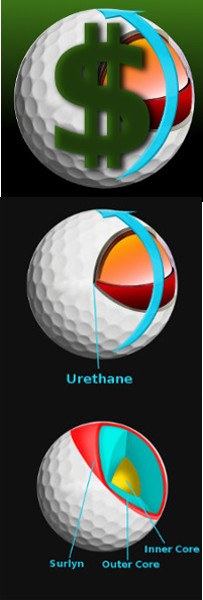
Narrowing Down the Field
You should be able to eliminate a large section of the market before you ever step foot in your local golf shop. This will help for a couple of reasons. First, you will be able to save time by not having to consider all of the various balls that the shop will have for sale. Also, you won't have to worry about getting 'sold' on a more expensive golf ball by a pushy salesperson. As long as you know what you are after, you should be able to track it down without any sales hype from the shop staff.
To start with, you want to focus on a specific price range for your purchase. If you are a beginning golfer, or a golfer who still struggles to consistently hit quality shots, there is no reason to spend more than $20 on a dozen golf balls – and you may be able to spend considerably less. As a good rule of thumb, any player who usually shoots in the 100's for an 18-hole round should be using a discount model ball. The features and capabilities of more expensive golf balls simply aren't going to be utilized by a player of this level, and the higher price tag is going to start to hurt as you continue to lose balls into the ponds, woods, and backyards around your local course. If you feel that you are still learning your game and you have a long way to go in that process, buy an affordable two-piece ball and spend the rest of your golf money on lessons to improve your swing.
If you are a player who often shoots somewhere in the 80's or 90's for a typical 18-hole round, a ball that is a step up from the bargain two-piece models is where you should focus your attention. Most likely, that means picking from the three-piece designs that fall somewhere in the $20-$30 per dozen range. These are not the top of the line golf balls that are played by the pros, but they do offer better performance characteristics than the cheapest balls in the store. This range of golf balls will give you the ability to put some spin on your shots, and you will have a little better feel coming off of the club when playing on and around the green. Think of this ball as a nice transition from the discount models to the premium brands.
It is only players who regularly shoot in the 70's and even 60's who will really benefit from using a premium golf ball. A top-end model from a well-known brand is going to cost you $40 or more per dozen, but that is the price you are going to have to pay if you want to enjoy the top-of-the-line performance that these balls offer. The two calling cards of golf balls in this price range are high spin rates and great feel around the greens. Also, when struck properly by a player with a powerful swing, these golf balls can travel impressive distances.
By far the most common mistake that is made by amateur golfers when picking out a golf ball is thinking that there will be no harm in moving up to a higher level ball – even if that ball is meant for better golfers. This is not only a mistake that will cost you money, but it will cost you strokes on the scorecard as well. For example, if you are a player who regularly shoots in the 100's but you decide to buy a box of balls that costs $40 or $50, you are going to be making the game harder for yourself. Those golf balls spin at a much higher rate than the discount balls, and your swing likely is not consistent enough to control that spin. This means that your poor shots are going to travel farther off line than ever before, and you will inevitably shoot higher scores as a result. Buying cheaper golf balls isn't just about saving money – it's about using a ball that is built to match with your skill level.
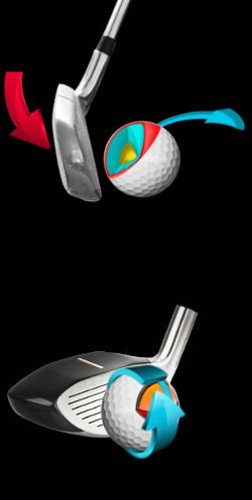
On-Course Trials
The information above should help you to narrow down your golf ball choices to just a few models. However, you won't be able to pick out a specific model without going a bit further. Even golf balls that have the same number of layers will have subtle differences between them, so testing them out for yourself on the course is really the only way to go. After trying a few different golf balls on the course, it should be easy to make your pick on which ball is going to find a permanent home in your bag.
In order to conduct some trials on the course without breaking the bank, the best thing you can do is to buy sleeves of three balls rather than full dozens. Pick our three or four golf ball models that you are interested in trying, and pick up a sleeve of each. Then, over the course of your next few rounds of golf, try each of them out one by one. Pay attention to how they fly through the air, how far they go, how much they curve, how they feel around the greens, and more. If necessary, write down your observations so you don't forget which ball excels in which area. It will take a few rounds in order to gather all of the info you need, but this will be time well spent as you shouldn't need to repeat this process for many seasons to come. As long as the golf ball you select remains available and on the market, you can continue to use it for the foreseeable future.
As you are testing your golf ball options, remember that there is more to this game than just distance. It is easy to get caught up in the game of which ball travels the farthest in the air, but that is only one of many important points – and it is not actually the most important point. The biggest thing you should be watching for is the control that you have over the ball as it comes off of your clubs. Are you able to accurately curve the ball the right amount for the shot at hand, or does the flight feel out of control at times? Control is what is going to allow you to shoot low scores, so you absolutely need to feel as though the ball is going to do what you want it to do while in the air. When you find a ball that seems to 'obey your commands', stick with it for the long run –even if it isn't the longest golf ball in your test.
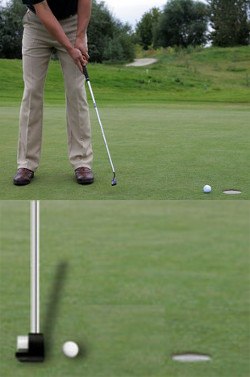
The Short Game Factor
The golf ball that you pick to use on a consistent basis will have just as much of an impact on your short game as it does on your long game. Feel is crucial in the short game, and you will need to be able to feel the ball coming off of the club when both putting and chipping if you are going to find good results. If the ball you pick out has no feel, or you can't seem to get it to work with your short game for whatever reason, it is not going to be a successful relationship. As you are testing out various golf balls before making a final selection, but sure to spend plenty of time on and around the greens to find one that will work for your short game as well as for the rest of your needs.
It is speed control that is ultimately the most important element of the short game, both with your putter and with your wedges. You won't have any trouble getting the ball on line from close range, so the short game is all about your ability to hit the ball the right distance. This is where feel comes in. If you know how the ball is going to feel off of your putter and your wedges, you will be able to make the right kind of swing to send the ball the appropriate distance. Obviously the ball isn't going to be able to do the work for you, as you still have to hit the shot, but a ball that feels good to you in the short game can make the task easier. Testing for this part of a ball's performance can be a simple as rolling some long putts back and forth across the practice green to see which ball you manage best.
The other important element of the short game is spin while chipping and hitting bunker shots. You don't need a ball that is going to stop immediately when it lands, but it is helpful to have a ball with at least a modest spin rate on short shots. It is important to note, due to the type of construction that is used in the golf ball, that the spin rate on full shots and short shots might not match up. It is possible to have a ball with a relatively soft cover that will spin on short shots while a firm core means it won't spin much on a full swing. Again, testing this out in your own game is the only way to know how it will play out on the course. Hit a number of chip shots from a clean lie toward the practice green and watch them carefully as they land. Once you get a good idea for the spin profile of each ball, you will be able to make a better selection on which is the right choice for you.
There is no right or wrong answer when trying to determine how many layers your golf ball should have. The needs of every player are unique, so you will have to think about your own game and do some testing in order to come to a smart conclusion. Once you do have a good ball for your game, make sure you stick with it for as long as possible. That relationship will only get better with time, and you will find that your performance gradually improves as you learn more and more about how the ball will react off of the club. Good luck!







